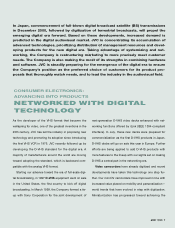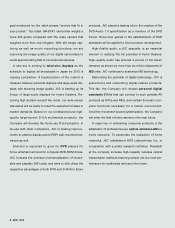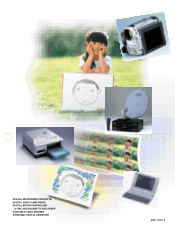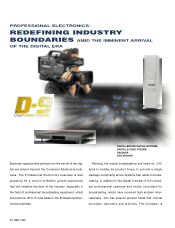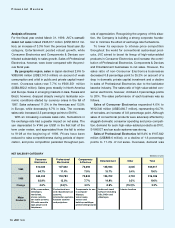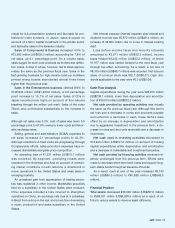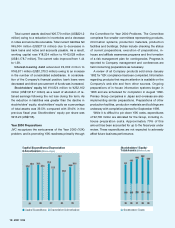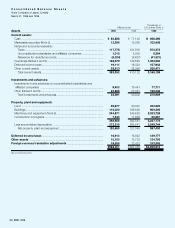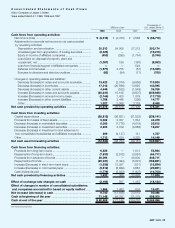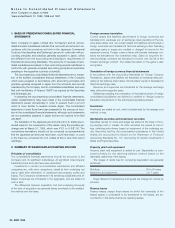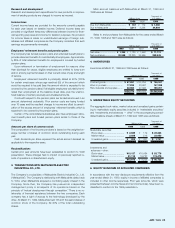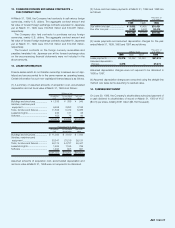JVC 1999 Annual Report Download - page 19
Download and view the complete annual report
Please find page 19 of the 1999 JVC annual report below. You can navigate through the pages in the report by either clicking on the pages listed below, or by using the keyword search tool below to find specific information within the annual report.
robust for ILA presentation systems and favorable for pro-
fessional video systems. In Japan, sales dropped on
account of a fall in capital investment in the private sector
and lackluster sales in the karaoke industry.
Sales of Components & Devices increased 4.0% to
¥73,693 million (US$609.0 million), accounting for 7.8% of
net sales, up 0.1 percentage point. On a volume basis,
sales surged for such core products as motors and deflec-
tion yokes. A drop in prices, however, led to sales approxi-
mately the same as the previous fiscal year. Sales in the
fast-growing business for high-density build-up multilayer
printed wiring boards skyrocketed almost three times
higher than the previous year.
Sales in the Entertainment business climbed 8.9% to
¥148,934 million (US$1,230.9 million), a 0.8 percentage
point increase to 15.7% of net sales. Sales of CDs in
Japan recorded new highs on account of four albums
breaking through the million unit mark. Sales of the video
Titanic also contributed substantially to the increase in
sales.
Although net sales rose 3.3%, cost of sales was down 0.9
percentage point to 67.8% owing to lower costs and favor-
able exchange rates.
Selling, general and administrative (SG&A) expenses to
net sales increased 2.1 percentage points to 32.3%.
Although reductions in fixed costs are progressing through
Companywide efforts, sales promotion expenses have in-
creased dramatically alongside price competition.
An operating loss of ¥1,221 million (US$10.1 million)
was recorded. By segment, operating losses were
recorded in the Americas and Asia on account of worsen-
ing market conditions in Latin America, a downtrend in
movie operations in the United States and weak sales in
emerging markets.
An unrealized gain from appreciation of trading securi-
ties was registered in other income. Marketable securities
held by a subsidiary in the United States were revalued.
Other expenses included a loss incurred to strengthen
operations in China, an exchange rate loss at a subsidiary
in Brazil from a drop in the real, and a loss from downsizing
a music production and sales subsidiary in the United
States.
Net interest expense (interest expense plus interest and
dividend income) was ¥5,972 million (US$49.4 million), an
increase of ¥2,663 million due to a rise in interest-bearing
debt.
Loss before income taxes and minority interests
amounted to ¥3,671 million (US$30.3 million). Income
taxes totaled ¥6,443 million (US$53.2 million), of which
¥1,977 million was carried forward to the next fiscal year
through tax-effect accounting. As a result, a net loss of
¥8,315 million (US$68.7 million) was recorded. Net loss per
share of common stock was ¥32.7 (US$0.27). Cash divi-
dends applicable to the year were ¥5.0 (US$0.04).
Cash Flow Analysis
Capital expenditures during the year were ¥28,815 million
(US$238.1 million), lower than depreciation and amortiza-
tion of ¥30,513 million (US$252.2 million).
Net cash provided by operating activities was virtually
the same as the previous fiscal year. Although this term’s
net loss and a decrease in notes and accounts payable
accounted for a decrease in cash, these factors were
offset by an increase in depreciation and amortization
due to aggressive investment in the previous term, a de-
crease in notes and accounts receivable and a decrease in
inventories.
Net cash used in investing activities decreased to
¥12,943 million (US$107.0 million) on account of holding
capital expenditures within depreciation and amortization
and a decrease in marketable and investment securities.
Net cash provided by financing activities remained rel-
atively unchanged from the previous term. Efforts were
made to decrease short-term bank loans and acquire long-
term stable funds through an issuance of bonds.
As a result, cash at end of the year increased ¥9,740
million (US$80.5 million) to ¥80,888 million (US$668.5
million).
Financial Position
Total assets decreased ¥36,049 million (US$297.9 million)
to ¥588,001 million (US$4,859.5 million) as a result of ef-
forts to reduce assets to improve asset efficiency.
JVC 1999 17


